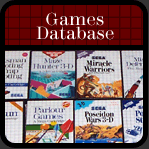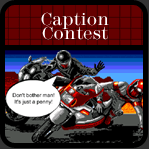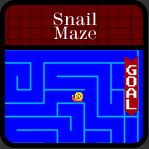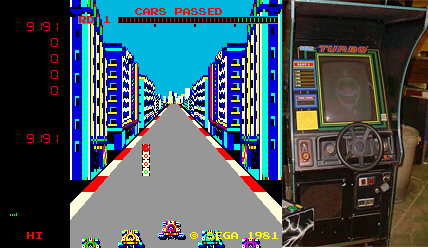 |
||
|---|---|---|
| Turbo Screenshot and an Upright Version |
Turbo was a racing game released in October of 1981. Contrary to what you may think, it was the first full-color, sprite-scaling game of its kind. This distinction, thus, does not go to Pole Position. Turbo was released in three different versions; a sit-down, 'cabaret' and standing type (last shown above). Even today its gameplay is unique in that, instead of beating a time limit or racing around a track the player's primary goal is passing opponent cars. Turbo, through its popularity, was the bar to which all racing games thereafter were based. In fact, modern racing games still follow this same basic idea and design. Turbo was eventually ported to Colecovision, Intellivision and the Commodore 64 (the latter as 'Death Race 64'). So popular was Turbo, in fact, it was made into a board game by Milton Bradley. It never saw release on any of Sega's home consoles, however.
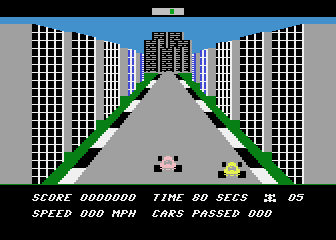 |
||
|---|---|---|
| Screenshot from Death Race |
 |
||
|---|---|---|
| Tubro Board Game |
But in spite of Turbo's importance in the history of video games, Steve actually considers it his worst experience working with Sega, because he was hospitalized for over a month after spending hours upon hours coding and debugging the title. In addition, though he didn't know it at the time, he suffers from what he later discovered to be spontaneous pneumothorax, which is essentially a spontaneously, collapsing lung. His condition was heightened by the stress, and he had to take some time off from work. Regardless, he dedicated himself to his profession and moved on in Sega's arcade division before helping in the creation of the Master System. What else did he do before he worked with Sega in the SMS era?
The next title he programmed was 'Monster Bash,' a platforming game similar to Mappy released in November of 1982. Don't be fooled, though, that's a really basic choice for comparison just to give you an idea of what it feels like, because Monster Bash contains a variety of complex features. The basic idea is that you control your hero, 'Little Red,' moving around three different creepy environments to take on monsters and a head creature on each level. The feature that might stand out to you is the lighting of candles, which enable you to use a special sword to kill Dracula, Frankenstein and then the 'Chameleon Man.' If you haven't figured it out already and it doesn't sound familiar, it was eventually altered significantly and released for the Master System as 'Ghost House.' Here, check out some comparisons:
 |
||
|---|---|---|
| Comparison of Monster Bash and Ghost House |
Out of his arcade titles that he programmed, Steve's favorite was 'Sinbad Mystery' because of its combination of maze-crawling and puzzle-solving. Sinbad Mystery, as fans of the SG-1000 already know, is similar to Pac-Man with its usage of maze-like environments. The player moves around the playing field, stepping over '?' marks, so that, piece by piece, a map is revealed on the right that indicates the location of hidden treasure. Find it, and you move on to the next level. Here's the original arcade flyer:
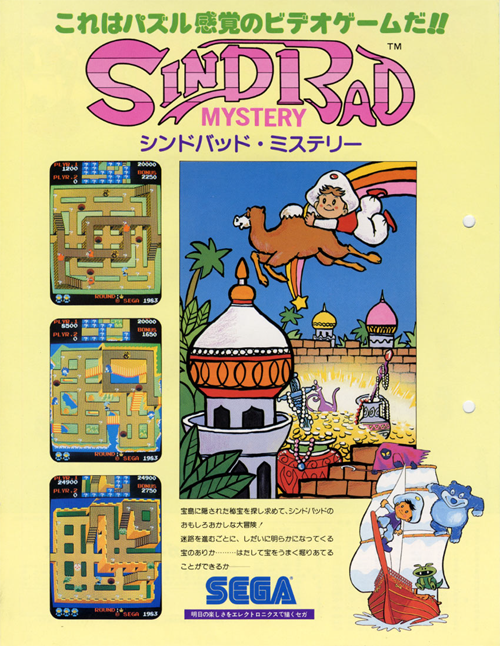 |
||
|---|---|---|
| Arcade Flyer from Sinbad Mystery |
After the release of Sinbad Mystery, Steve moved to the United States and worked on a US localized version for the arcades. It was put on 'income test,' a simple idea where machines were placed in locations to see how much they were played. Sinbad faired reasonably well, but before it could be released Sega closed their US coin-up division following the video game crash. The crash had nothing to do with arcade titles, which continued to see popularity, but due to the strain on the company that owned Sega at the time, Gulf & Western, the company was sold to Sega of Japan and the arcade division was temporarily shut down in 1985.
During this time, Steve's last game was also canceled as Sega switched its arcade focus back to Japan before the company was repurchased and the new US subsidy reopened in California. 'Midnight Magic' was intended to be an action-maze game similar to the Sega/Gremlin title 'Head On' from 1979; a fast-paced racing game. Here's a quick screenshot from that:
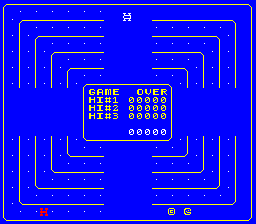 |
||
|---|---|---|
| Screenshot from Head On |
In Midnight Magic, the player was to control a pair of 'magician's hands' to move quickly around a maze, clapping them together to eliminate enemies while avoiding others and collecting icons along the playing field. It was ended quite early in the development process, so unfortunately nothing from his work on it exists since it was only in the design stages.
During this time, when Steve finished a title for the Japanese market, he would then typically be given the task of localizing the product for the US, spending several weeks in the states and then returning to Japan to start anew. Because of this, Sega eventually wanted Steve to remain permanently in the United States in order to foster a better line of communication between Japanese and US engineers. This leads us into the next part of the story and another step towards the Master System...
Next Page


